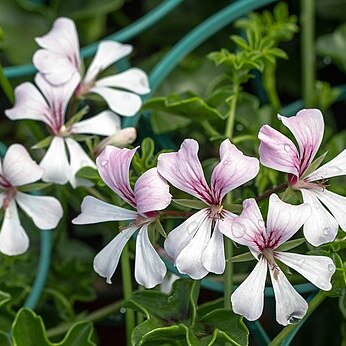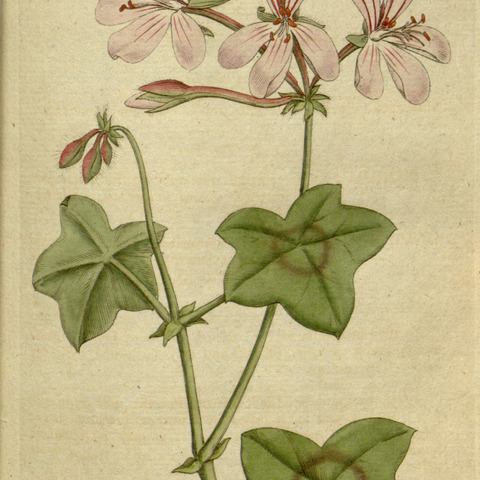Long-trailing or scrambling herb; stems with retrorse appressed hairs. Lvs peltate; stipules large, oblong-ovate, ovate, or broad-ovate; petiole generally < blade. Lamina to c. 8 × 10 cm, usually 5-lobed 1/4-⅓ way to midrib, the lower lobes sometimes with small basal secondary lobe, semi-succulent, glabrous or nearly so above, often with small dark zone above near petiole insertion; veins beneath hairy, especially on young lvs; margins red, ciliate. Umbels usually 3-7-flowered, eglandular; peduncles to c. 40 cm long, with retrorse hairs; pedicels 0.3-1 cm long; bracts forming an involucre. Sepals 12-14 mm long, 4 lanceolate, 1 narrow-ovate, reddish or purplish, densely hairy or glabrate; calyx spur 0.8-1.5 cm long. Corolla usually pale to deep pink, sometimes mauve, often semi-double (petaloid staminodes); upper 2 petals (1.5)-2.2-3 cm long, obovate; claw with median white band bordered by dark crimson line; limb rounded, truncate or slightly emarginate; lower 3 petals smaller and without claw markings. Ovary and lower part of style villous; style and stigma pink or mauve. Mericarps not seen.
Perennial creeper, 0.1-2.0 m high; stems smooth, tender. Leaves fleshy, lamina peltate, 20-70 mm in diam., 5-angled or lobed, sometimes zoned, base cordate, margins entire, surface hairy; petioles shorter than leaf blades. Stipules broadly ovate. Inflorescences of 2-9-flowered pseudo-umbels; peduncles long. Flowers zygomorphic; long-spurred. Petals 5, mauve, pinkish mauve to pale pink or whitish; posterior petals with darker markings. Flowering time all year, mostly spring.
A shrubby herb. It is evergreen and keeps growing from year to year. It is creeping. It grows 30 cm high and spreads 60-120 cm wide. It has long trailing stems. The leaves are ivy like and glossy green. They are almost round but with lobes. The flowers occur in clusters. They can be single or double. They are 2.5 cm wide and the petals do not overlap. They are white, pink or lavender.
Scrambling vine to 4 m. Leaves round, sometimes peltate, often 5-7-lobed, leathery-succulent and with reddish zonal marking. Flowers 2-9, 40-50 mm diam., pale pink to purple, subsessile; hypanthium 30-50 mm long.


